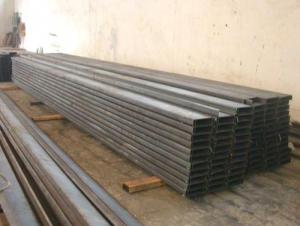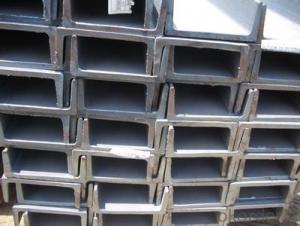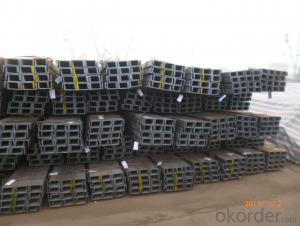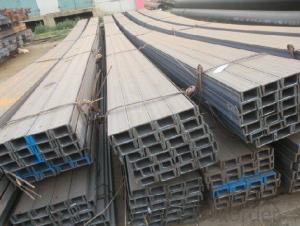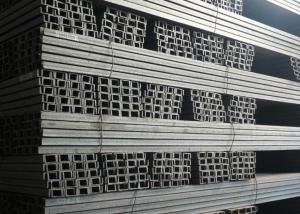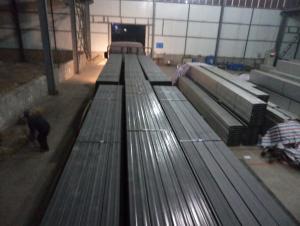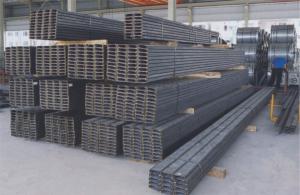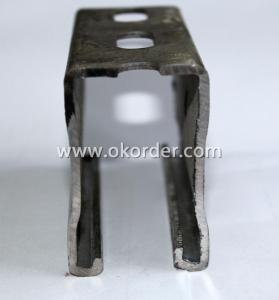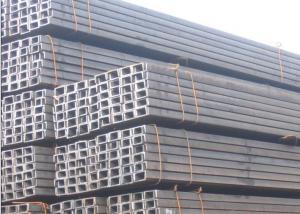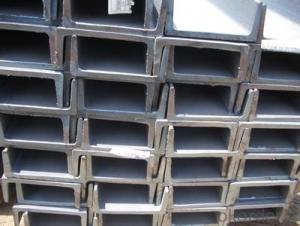JIS U-Channels with Lowest Price Hot Rolled
- Loading Port:
- Tianjin
- Payment Terms:
- TT OR LC
- Min Order Qty:
- 25 m.t
- Supply Capability:
- 10000 m.t/month
OKorder Service Pledge
OKorder Financial Service
You Might Also Like
Specification
Okorder.com is a professional materials & equipment supplier & manufacturer, offers integrated one-stop services including real-time quoting and online cargo tracking. We are funded by CNBM Group, a Fortune 500 enterprise and the largest materials & equipment firm in China.
Product Applications:
The MS Channel can be applied to construction of warehouses, workshops, sport stadiums and car parks etc.The hot rolled channel steel belongs to carbon structural steel which is applied to in the field of construction and machinery.In details, the hot rolled channel steel is usually used for arch-itechtural structure, and they could be welded in order to support or hang a vari-ety of facilities. They are also usually used in combination with I beam. Generally,the hot rolled channel steel we supply must possess perfect welding property, riveting property and mechanical property and so on.
Product Advantages:
OKorder's Steel U-Channels are durable, strong, and resist corrosion.
Main Product Features:
· Premium quality
· Prompt delivery & seaworthy packing (30 days after receiving deposit)
· Corrosion resistance
· Can be recycled and reused
· Mill test certification
· Professional Service
· Competitive pricing
Product Specifications:
1.We supply high quality MS Channel at reasonable price, including Chinese standard, Japanese standard and so on.
Standard | GB/JIS |
Material Grade | Q235,SS400 |
Technique: | Hot Rolled |
Sizes as per chinese standard: | 50*37*4.5mm - 300*89*11.5mm |
Sizes as per japanese standard: | 50*25*3mm – 200*80*7.5mm |
Length: | 6meter, 9meter, 12meter |
Note: 1.we are also competent to provide our customers other MS Channel based on other sizes according to customer’s requirements.
2. The length of our ms channel could be cut into other meters as per customer’s requirements. For example, the channel in 6meters could be cut into 5.8meters in order to be fit in the 20ft container.
2. The detailed sections of MS Channel as per GB standard.are shown in the table-1:
GB U CHANNEL | Standard | Sectional | Dimension |
| Mass: |
| (mm) | (mm) | (mm) | (mm) |
|
50X37 | 50 | 37 | 4.50 | 7.0 | 5.438 |
63X40 | 63 | 40 | 4.80 | 7.5 | 6.634 |
80x43 | 80 | 43 | 5.00 | 8.0 | 8.045 |
|
|
|
|
|
|
100x48 | 100 | 48 | 5.30 | 8.5 | 10.007 |
120x53 | 120 | 53 | 5.50 | 9.0 | 12.059 |
140x58 | 140 | 58 | 6.00 | 9.5 | 14.535 |
140x60 | 140 | 60 | 8.00 | 9.5 | 16.733 |
|
|
|
|
|
|
160x63 | 160 | 63 | 6.50 | 10.0 | 17.240 |
160x65 | 160 | 65 | 8.50 | 10.0 | 19.752 |
|
|
|
|
|
|
180x68 | 180 | 68 | 7.00 | 10.5 | 20.174 |
180x70 | 180 | 70 | 9.00 | 10.5 | 23.000 |
|
|
|
|
|
|
200x73 | 200 | 73 | 7.00 | 11.0 | 22.637 |
200x75 | 200 | 75 | 9.00 | 11.0 | 25.777 |
|
|
|
|
|
|
220x77 | 220 | 77 | 7.00 | 11.5 | 24.999 |
220x79 | 220 | 79 | 9.00 | 11.5 | 28.453 |
|
|
|
|
|
|
250x78 | 250 | 78 | 7.00 | 12.0 | 27.410 |
250x80 | 250 | 80 | 9.00 | 12.0 | 31.335 |
250x82 | 250 | 82 | 11.00 | 12.0 | 35.260 |
|
|
|
|
| |
280x82 | 280 | 82 | 7.50 | 12.5 | 31.427 |
280x84 | 280 | 84 | 9.50 | 12.5 | 35.823 |
280x86 | 280 | 86 | 11.50 | 12.5 | 40.219 |
|
|
|
|
|
|
300x85 | 300 | 85 | 7.50 | 13.5 | 34.463 |
300x87 | 300 | 87 | 9.50 | 13.5 | 39.173 |
300x89 | 300 | 89 | 11.50 | 13.5 | 43.883 |
Table-1
3. The chemical composition of HR Channel Steel according to Q235B is shown in Table-2.
Alloy No | Grade | Element(%) | ||||
C | Mn | S | P | Si | ||
Q235 | B | 0.12-0.20 | 0.3-0.7 | ≦0.045 | ≦0.045 | ≦0.3 |
Table-2
Note: we are able to present our customers relevant SGS test report for chemical composition of HR Channel Steel.
4. The mechanical property of HR Channel Steel according to Q235B is shown in Table-3-1 and Table-3-2
Alloy No | Grade | Yielding Strength Point(Mpa) | |||
Thickness(mm) | |||||
≦16 | >16-40 | >40-60 | >60-100 | ||
≧ | |||||
Q235 | B | 235 | 225 | 215 | 205 |
Table-3-1
Alloy No | Grade | Tensile Strength(Mpa) | Elongation After Fracture(%) | |||
Thickness(mm) | ||||||
≦16 | >16-40 | >40-60 | >60-100 | |||
≧ | ||||||
G235 | B | 375-500 | 26 | 25 | 24 | 23 |
Table-3-2
Note: we are able to present our customers relevant SGS test report for mechanical property of MS Channel as customer’s request.
FAQ:
Q1: Why buy Materials & Equipment from OKorder.com?
A1: All products are carefully selected from China's most reliable manufacturing enterprises. Through its ISO certifications, OKorder.com adheres to the highest standards and a commitment to supply chain safety and customer satisfaction. We can guarantee the quality!
Q2: The products are invoicing on theoretical weight or on actual weight?
A2: We can do it in both manners, it’s according to buyer's requirement.
Q3: Can fit in the containers of 20fts for 6M long ?
A3: Yes, we can put them into the containers in the form sideling, in this way we can save the buyer much ocean freight.
Images:


- Q: How do steel channels contribute to the overall aesthetics of a building?
- There are several ways in which steel channels can enhance the aesthetics of a building. Firstly, their modern and contemporary design adds a stylish and cutting-edge element to the structure. The clean lines and precise edges of steel channels create an attractive appearance, elevating the overall aesthetic appeal of the building. Moreover, steel channels offer a wide range of design possibilities, allowing for the creation of unique and intricate patterns that add visual interest to the building's facade. Whether used horizontally, vertically, or diagonally, steel channels provide an outlet for creative expression, enabling architects and designers to craft striking and captivating architectural features. Additionally, steel channels can be finished in various ways to complement the building's overall design concept. They can be painted in different colors, creating a bold or subtle contrast with the surrounding materials. Alternatively, steel channels can be left exposed, showcasing their natural metallic finish, which adds a touch of industrial elegance to the building's aesthetic. Furthermore, the durability and long-lasting nature of steel channels not only benefit the structure's stability but also contribute to its overall aesthetics. The longevity of steel channels ensures that the building maintains its visual appeal for years to come, without the need for frequent repairs or replacements. In conclusion, steel channels enhance the aesthetics of a building by adding a sleek and modern touch, offering versatile design options, allowing for various finishes, and providing durability. Their ability to enhance the visual appeal of a structure makes them a favored choice among architects and designers seeking to create aesthetically pleasing buildings.
- Q: How do steel channels compare to other structural steel shapes?
- Steel channels are a versatile structural steel shape that offer several advantages compared to other shapes. They are lightweight yet strong, making them suitable for a wide range of applications. Steel channels provide excellent structural support due to their C-shaped design, which allows for greater load-bearing capacity. Additionally, their flanges can be easily attached to other components, enhancing their versatility in construction projects. Overall, steel channels offer a cost-effective and efficient solution for various structural needs.
- Q: How do steel channels contribute to the energy efficiency of a building?
- There are several ways in which steel channels contribute to the energy efficiency of a building. Firstly, they can be used to create structural frames and support systems, which help evenly distribute the weight of the building. This allows for more open and flexible floor plans, reducing the need for additional support columns and walls. By minimizing the use of materials, steel channels optimize space utilization and reduce overall energy consumption during construction. In addition, steel channels are known for their high strength-to-weight ratio. This means they can support heavy loads while being relatively lightweight themselves. As a result, taller and larger buildings can be constructed, maximizing usable space without compromising structural integrity. This leads to greater energy efficiency in terms of land use, as more occupants can be accommodated within a smaller footprint. Durability and longevity are also important factors contributing to energy efficiency. Steel is highly durable, able to withstand extreme weather conditions and resist corrosion over time. This reduces the need for frequent repairs and replacements, resulting in lower maintenance costs and less energy consumption associated with building upkeep. Moreover, steel channels can be used as part of an efficient insulation system. Insulated steel channels can be integrated into the building envelope, creating a thermal barrier that helps regulate indoor temperature. This reduces reliance on heating and cooling systems, leading to lower energy consumption and improved energy efficiency. Lastly, steel channels are often made from recycled steel, which has a significantly lower carbon footprint compared to virgin steel production. By using recycled materials, the environmental impact of the building's construction is reduced, contributing to overall energy efficiency. In conclusion, steel channels contribute to the energy efficiency of a building through efficient structural designs, optimized space utilization, durability, insulation support, and the use of recycled materials. These factors collectively reduce energy consumption, improve building performance, and contribute to a more sustainable and environmentally friendly construction industry.
- Q: How are steel channels used in the construction of warehouses?
- Steel channels are commonly used in the construction of warehouses due to their strength and versatility. They are typically used to provide support and structural stability to the building. Steel channels are often used as beams or columns to carry heavy loads and distribute the weight evenly throughout the warehouse. They are able to withstand the weight of storage racks, equipment, and inventory, making them an essential component in warehouse construction. In addition to providing structural support, steel channels are also used for framing and bracing purposes. They help create a framework for the building, allowing for the installation of walls, roofs, and other components. This ensures that the warehouse is built to withstand various external forces, such as wind and seismic loads. Steel channels are also used in the construction of mezzanine floors, which are intermediate levels between the main floors of a warehouse. These floors are commonly used for storage or office space and require strong and durable support. Steel channels provide the necessary strength and stability to ensure the safety and functionality of these additional levels. Moreover, steel channels are often utilized in the construction of conveyor systems within warehouses. These systems are used to transport goods and materials throughout the facility. Steel channels provide a sturdy base for the conveyor belts, ensuring smooth and efficient movement of items. Overall, steel channels play a vital role in the construction of warehouses by providing structural support, framing, bracing, and support for mezzanine floors and conveyor systems. Their durability, strength, and versatility make them an ideal choice for warehouse construction, ensuring the safety, efficiency, and longevity of these structures.
- Q: Can steel channels be used for creating overhead support structures?
- Yes, steel channels can be used for creating overhead support structures. Steel channels are commonly used in construction for their high strength and durability. They provide a stable and reliable framework for overhead support structures, such as beams and trusses, ensuring the safe and secure support of the load above.
- Q: What are the load capacities of steel channels?
- The load-carrying capabilities of steel channels depend on various factors, including the channel's dimensions, the type of steel employed, and the manner in which the load is applied. Due to their strength and durability, steel channels find widespread utilization in construction and engineering projects. Determining the load capacity of a steel channel involves engineering calculations and analysis. Engineers take into account parameters such as the channel's yield strength, ultimate strength, and moment of inertia to ascertain its load-bearing capacity. The yield strength of the steel establishes the maximum stress the channel can endure before undergoing permanent deformation. Conversely, the ultimate strength denotes the maximum stress the channel can withstand before experiencing complete failure. These values are generally provided by the manufacturer or can be acquired from engineering reference materials. Furthermore, the load capacity of a steel channel is influenced by its dimensions. Larger cross-sectional areas in channels generally lead to higher load capacities as they enable the load to be distributed across a larger surface area. Moreover, the channel's shape and design, including the presence of flanges, may impact its ability to bear loads. It is crucial to note that load capacities for steel channels can significantly vary depending on the specific application and the required safety factors. Aspects such as the load type (e.g., static or dynamic), channel length, and support conditions also contribute to determining the load capacity. To ensure structural integrity and safety, it is advisable to consult a structural engineer or refer to industry standards and codes when determining the load capacities of steel channels for a particular application.
- Q: Can steel channels be used in the automotive parts manufacturing industry?
- Yes, steel channels can be used in the automotive parts manufacturing industry. Steel channels are commonly used in the automotive industry for various applications such as structural components, frames, body panels, reinforcements, and chassis parts. Steel channels offer high strength and durability, making them suitable for withstanding the demanding conditions and loads experienced by automotive parts. Additionally, steel channels can be easily shaped, cut, and welded, allowing for efficient customization and fabrication of automotive components. The use of steel channels in the automotive parts manufacturing industry helps ensure the production of robust and reliable automotive parts.
- Q: Can steel channels be used for machinery platforms?
- Yes, steel channels can be used for machinery platforms. Steel channels are commonly used in construction and industrial applications due to their high strength and durability. They provide a stable and secure platform for heavy machinery, ensuring safety and stability during operation.
- Q: Which bearing capacity is stronger?
- Under the same thickness, the bearing capacity of I-beam will be better than that of channel steel, and the price of channel steel will be lower than that of i-beam.
- Q: How do steel channels perform under dynamic loads?
- Known for their high strength and load-bearing capacity, steel channels are ideal for effectively handling dynamic loads. Vibrations, impacts, and fluctuating forces are easily managed by steel channels, as they exhibit exceptional performance and durability. The structural design of steel channels allows for the efficient dispersion of dynamic loads throughout their length, effectively preventing localized stress concentrations. This characteristic is critical in applications that involve repeated loading, as it minimizes the risk of fatigue failure. Moreover, steel channels possess excellent stiffness, enabling them to maintain their shape and integrity when subjected to dynamic loads. This stiffness ensures the overall stability and safety of the structure, as it resists bending, twisting, and deformation. Additionally, steel channels have a high level of ductility, meaning they can withstand significant deformation without fracturing. This is crucial in scenarios involving dynamic loading events, like impacts or earthquakes, as it reduces the likelihood of catastrophic failure by absorbing and dissipating energy. Furthermore, steel channels are often used in conjunction with other structural components, such as bolts, welds, or connectors, to enhance their load-bearing capacity. By combining steel channels with these reinforcements, their resistance to shear, torsion, and bending forces is further increased, resulting in improved performance under dynamic loads. In conclusion, steel channels are an excellent choice for handling dynamic loads due to their impressive strength, exceptional load distribution capabilities, stiffness, ductility, and compatibility with reinforcements. These qualities make them a reliable option for various applications that require the ability to withstand dynamic forces, guaranteeing the durability and safety of the structures in which they are utilized.
Send your message to us
JIS U-Channels with Lowest Price Hot Rolled
- Loading Port:
- Tianjin
- Payment Terms:
- TT OR LC
- Min Order Qty:
- 25 m.t
- Supply Capability:
- 10000 m.t/month
OKorder Service Pledge
OKorder Financial Service
Similar products
Hot products
Hot Searches
Related keywords












